4.5E: Exercises
This page is a draft and is under active development.
( \newcommand{\kernel}{\mathrm{null}\,}\)
Exercise \PageIndex{1}
1) If c is a critical point of f(x), when is there no local maximum or minimum at c? Explain.
2) For the function y=x^3, is x=0 both an inflection point and a local maximum/minimum?
- Answer
-
It is not a local maximum/minimum because f′ does not change sign
3) For the function y=x^3, is x=0 an inflection point?
4) Is it possible for a point c to be both an inflection point and a local extrema of a twice differentiable function?
- Answer
-
No
6) Why do you need continuity for the first derivative test? Come up with an example.
7) Explain whether a concave-down function has to cross y=0 for some value of x.
- Answer
-
False; for example, \(y=\sqrt{x}\).
8) Explain whether a polynomial of degree 2 can have an inflection point.
- Answer
-
Under Construction.
Exercise \PageIndex{2}
For the following exercises, analyze the graphs of f′, then list all intervals where f is increasing or decreasing.
1)
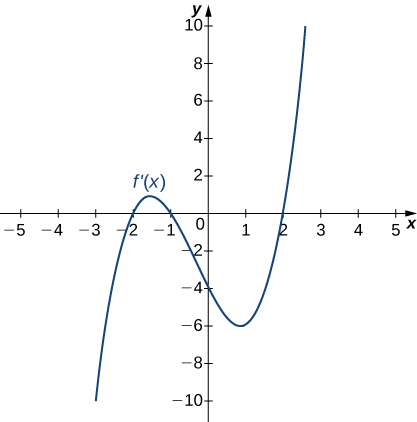
- Answer
-
Increasing for −2<x<−1 and x>2; decreasing for x<−2 and −1<x<2
2)

3)
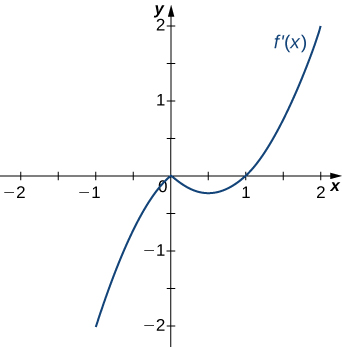
- Answer
-
Decreasing for x<1, increasing for x>1
4)
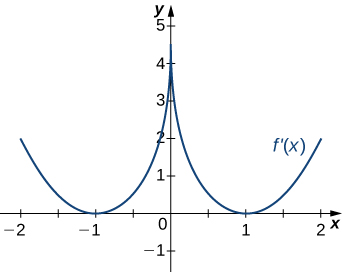
5)
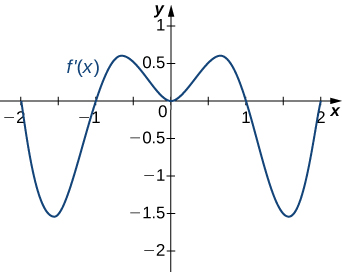
- Answer
-
Decreasing for −2<x<−1 and 1<x<2; increasing for −1<x<1 and x<−2 and x>2
Exercise \PageIndex{3}
For the following exercises, analyze the graphs of f′, then list all intervals where
a. f is increasing and decreasing and
b. the minima and maxima are located.
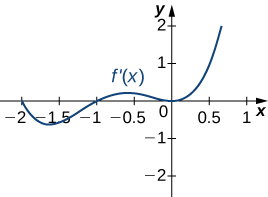
1)
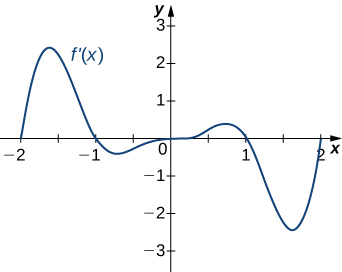
- Answer
-
a. Increasing over −2<x<−1,0<x<1,x>2, decreasing over x<−2, −1<x<0,1<x<2; b. maxima at x=−1 and x=1, minima at x=−2 and x=0 and x=2
2)
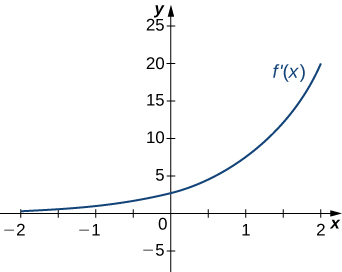
3)
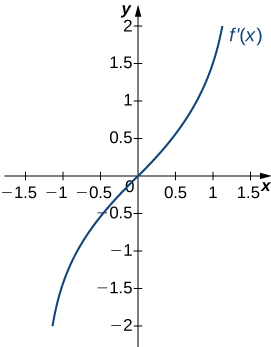
- Answer
-
a. Increasing over x>0, decreasing over x<0; b. Minimum at x=0
4)
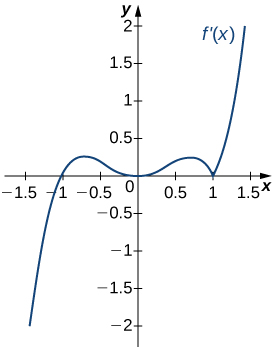
Exercise \PageIndex{4}
For the following exercises, analyze the graphs of f′, then list all inflection points and intervals f that are concave up and concave down.
1)
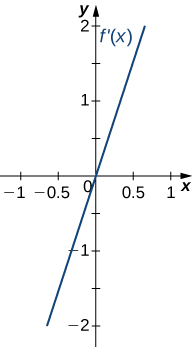
- Answer
-
Concave up on all x, no inflection points
2)
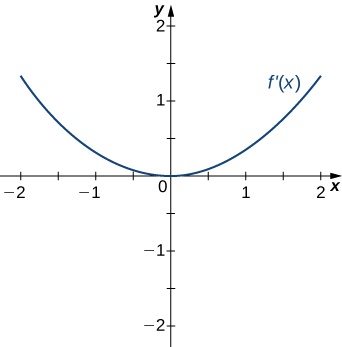
3)
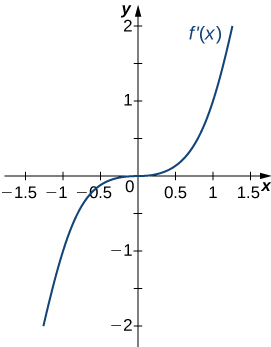
- Answer
-
Concave up on all x, no inflection points
4)
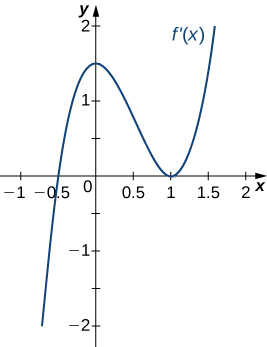
5)
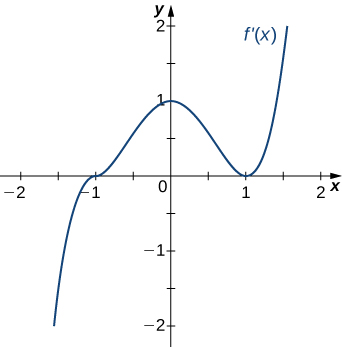
- Answer
-
Concave up for x<0 and x>1, concave down for 0<x<1, inflection points at x=0 and x=1
Exercise \PageIndex{5}
For the following exercises, draw a graph that satisfies the given specifications for the domain x=[−3,3] The function does not have to be continuous or differentiable.
1) f(x)>0,f′(x)>0 over x>1,−3<x<0,f′(x)=0 over 0<x<1
2) f′(x)>0 over x>2,−3<x<−1,f′(x)<0 over −1<x<2,f''(x)<0 for all x
3) f''(x)<0 over −1<x<1,f''(x)>0,−3<x<−1,1<x<3, local maximum at x=0, local minima at x=±2
4) There is a local maximum at x=2, local minimum at x=1, and the graph is neither concave up nor concave down.
5) There are local maxima at x=±1, the function is concave up for all x, and the function remains positive for all x
- Answer
-
2)Decreasing for \(−1<x<2\) ; increasing for \(−3<x<−1\) and x>2; Concave down for all x.
Exercise \PageIndex{6}
For the following exercises, determine
a. intervals where f is increasing or decreasing and
b. local minima and maxima of f.
1) f(x)=sinx+sin^3x over −π<x<π
- Answer
-
a. Increasing over −\frac{π}{2}<x<\frac{π}{2}, decreasing over x<−π\frac{π}{2},x>\frac{π}{2}
b. Local maximum at x=\frac{π}{2}; local minimum at x=−\frac{π}{2}
2) f(x)=x^2+cosx
- Answer
-
Under Construction
Exercise \PageIndex{7}
For the following exercises, determine
a. intervals where f is increasing or decreasing,
b. local minima and maxima of f,
c. intervals where f is concave up and concave down, and
d. the inflection points of f
1) f(x)=x^3−4x^2+x+2
- Answer
-
a. Concave up for x>\frac{4}{3}, concave down for x<\frac{34}{3}
b. Inflection point at x=\frac{4}{3}
2) f(x)=x^2−6x
3) f(x)=x^3−6x^2
- Answer
-
a. Increasing over x<0 and x>4, decreasing over 0<x<4
b. Maximum at x=0, minimum at x=4
c. Concave up for x>2, concave down for x<2
d. Infection point at x=2
4) f(x)=x^4−6x^3
5) f(x)=x^{11}−6x^{10}
- Answer
-
a. Increasing over x<0 and x>\frac{60}{11}, decreasing over 0<x<\frac{60}{11}
b. Minimum at x=\frac{60}{11}
c. Concave down for x<\frac{54}{11}, concave up for x>\frac{54}{11}
d. Inflection point at x=\frac{54}{11}
6) f(x)=x+x^2−x^3
7) f(x)=x^2+x+1
- Answer
-
a. Increasing over x>−\frac{1}{2}, decreasing over x<−\frac{1}{2}
b. Minimum at x=−\frac{1}{2}
c. Concave up for all x
d. No inflection points
8) f(x)=x^3+x^4
Exercise \PageIndex{8}
For the following exercises, determine
a. intervals where f is increasing or decreasing,
b. local minima and maxima of f,
c. intervals where f is concave up and concave down, and
d. the inflection points of f Sketch the curve, then use a calculator to compare your answer. If you cannot determine the exact answer analytically, use a calculator.
1) f(x)=sin(\pi x)−cos(\pi x) over x=[−1,1]
- Answer
-
a. Increases over −\frac{1}{4}<x<\frac{3}{4}, decreases over x>\frac{3}{4} and x<−\frac{1}{4}
b. Minimum at x=−\frac{1}{4}, maximum at x=\frac{3}{4}
c. Concave up for −\frac{3}{4}<x<\frac{1}{4}, concave down for x<−\frac{3}{4} and x>\frac{1}{4}
d. Inflection points at x=−\frac{3}{4},x=\frac{1}{4}
- Solution
-
Since f(x)=sin(\pi x)−cos(\pi x) over x=[−1,1], f'(x)=\pi cos(\pi x)+\pi sin(\pi x).Critical points: f'(x)=\pi cos(\pi x)+\pi sin(\pi x)=0 \implies \pi cos(\pi x)=-\pi sin(\pi x) \implies cos(\pi x)=-sin(\pi x) \implies \pi x= \dfrac{3\pi}{4}, \dfrac{-\pi}{4} \implies x= \dfrac{3}{4}, \dfrac{-1}{4}. Note that \pi x\in [-\pi , \pi], not [0 , 2\pi].

Thus,
a. Increases over −\frac{1}{4}<x<\frac{3}{4}, decreases over x>\frac{3}{4} and x<−\frac{1}{4}.
b. Minimum at x=−\frac{1}{4}, maximum at x=\frac{3}{4}.
Concavity: f'(x)=\pi cos(\pi x)+\pi sin(\pi x) \implies f''(x)=-\pi^2 sin(\pi x)+\pi^2 cos(\pi x). Now solve f''(x)=-\pi^2 sin(\pi x)+\pi^2 cos(\pi x)=0. Thus cos(\pi x)=sin(\pi x). Which implies, \pi x= \dfrac{-3\pi}{4}, \dfrac{\pi}{4} \implies x= \dfrac{-3}{4}, \dfrac{1}{4}.

Thus,
c. Concave up for −\frac{3}{4}<x<\frac{1}{4}, concave down for x<−\frac{3}{4} and x>\frac{1}{4}.
d. Inflection points at x=−\frac{3}{4},x=\frac{1}{4}.
2) f(x)=x+sin(2x) over x=[−\frac{π}{2},\frac{π}{2}]
3) f(x)=sinx+tanx over (−\frac{π}{2},\frac{π}{2})
- Answer
-
a. Increasing for all x
b. No local minimum or maximum
c. Concave up for x>0, concave down for x<0
d. Inflection point at x=0
4) f(x)=(x−2)^2(x−4)^2
5) f(x)=\frac{1}{1−x},x≠1
- Answer
-
a. Increasing for all x where defined
b. No local minima or maxima
c. Concave up for x<1; concave down for x>1
d. No inflection points in domain
6) f(x)=\frac{sinx}{x} over x=[−2π,2π] [2π,0)∪(0,2π]
7) f(x)=sin(x)e^x over x=[−π,π]
- Answer
-
a. Increasing over −\frac{π}{4}<x<\frac{3π}{4}, decreasing over x>\frac{3π}{4},x<−\frac{π}{4}
b. Minimum at x=−\frac{π}{4}, maximum at x=\frac{3π}{4}
c. Concave up for −\frac{π}{2}<x<\frac{π}{2}, concave down for x<−\frac{π}{2},x>\frac{π}{2}
d. Infection points at x=±\frac{π}{2}
8) f(x)=lnx\sqrt{x},x>0
9) f(x)=\frac{1}{4}\sqrt{x}+\frac{1}{x},x>0
- Answer
-
a. Increasing over x>4, decreasing over 0<x<4
b. Minimum at x=4
c. Concave up for 0<x<8\sqrt[3]{2}, concave down for x>8\sqrt[3]{2}
d. Inflection point at x=8\sqrt[3]{2}
- Solution
-
f(x)=\dfrac{1}{4}\sqrt{x}+\dfrac{1}{x},x>0. f'(x)=\dfrac{1}{8\sqrt{x}}+\dfrac{-1}{x^2}=\dfrac{x^2- 8\sqrt{x}}{8x^2\sqrt{x}}=\dfrac{x^{3/2}- 8}{8x^2}, since x >0. Critical points: x^{3/2}- 8=0 \implies x^{3/2}= 8 \implies x=(8)^{2/3} =(2^3)^{2/3} \implies x=4. We will create sign chart using test points:
(0,4) Test point x=2 (4,\infty) Test point x=8 x^{3/2}- 8 - + 8x^2 + + Sign of f' - + Thus f increasing over x>4, decreasing over 0<x<4 and has a local minimum of f(4)=\dfrac{1}{4}\sqrt{4}+\dfrac{1}{4}=\dfrac{3}{4} at x=4.
Concavity: f'(x)=\dfrac{1}{8\sqrt{x}}+\dfrac{-1}{x^2}, f''(x)=\dfrac{-1}{16x^{3/2}}+\dfrac{2}{x^3}= \dfrac{-x^{3/2}-32}{16x^3}. Now solve x^{3/2}-32=0 \implies x^{3/2}=32 \implies x=32^{2/3}=2^{10/3}=8\sqrt[3]{2}.
Using the table below:
f is concave up for 0<x<8\sqrt[3]{2}, concave down for x>8\sqrt[3]{2} and has an inflection point at x=8\sqrt[3]{2}.
(0,8\sqrt[3]{2}) Test point x=4 (8\sqrt[3]{2},\infty) Test point x=16 x^{3/2}- 32 - + 16x^3 + + Sign of f' - + -
10) f(x)=\frac{e^x}{x},x≠0
11) f(x)=\frac{x}{ln(|x|)}
- Answer
-
a. Increasing over x>e, decreasing over -1<x<e
b. Minimum at x=e
c. Concave up for (-1,0) \cup (1, \infty)\\), concave down for \((0,1)
d. Inflection point at x=0
Exercise \PageIndex{9}
For the following exercises, interpret the sentences in terms of f,f′, and f''
1) The population is growing more slowly. Here f is the population.
- Answer
-
f>0,f′>0,f''<0
2) A bike accelerates faster, but a car goes faster. Here f= Bike’s position minus Car’s position.
3) The airplane lands smoothly. Here f is the plane’s altitude.
- Answer
-
f>0,f′<0,f''<0
4) Stock prices are at their peak. Here fis the stock price.
5) The economy is picking up speed. Here f is a measure of the economy, such as GDP.
- Answer
-
f>0,f′>0,f''>0
Exercise \PageIndex{10}
For the following exercises, consider a third-degree polynomial f(x), which has the properties f′(1)=0,f′(3)=0.
Determine whether the following statements are true or false. Justify your answer.
1) f(x)=0 for some 1≤x≤3
2) f''(x)=0 for some 1≤x≤3
- Answer
-
True, by the Mean Value Theorem
3) There is no absolute maximum at x=3.
4) If f(x) has three roots, then it has 1 inflection point.
- Answer
-
True, examine derivative
5) If f(x) has one inflection point, then it has three real roots.
For the following exercises, determine
a. intervals where f is increasing or decreasing,
b. local minima and maxima of f,
c. intervals where f is concave up and concave down, and
d. the inflection points of f.
1. f(x)=x^2 e^{-x}
2. f(x)=3(x^2-4)^{2/3}
3. f(x)=10x^3+ 3x^5
4. f(x)=e^{-x^2/2}
5.f(x)=x e^{-2x}
6. f(x)=x+\frac{1}{x}
7. f(x) =5x^3+ 2x^5
8. f(x)=\ln(1+x^2)
9. f(x)=(3-x^2)^2
10. f(t)=\dfrac{1}{1-t^2}
11. f(t)=e^{-t^2}
12. f(x) = x^{5/4}-x^{1/4}
13. f(x) = \ln (x^2+1)
14. f(x) = (\ln x)^2
15. f(x) = x-2 \tan^{-1}(x)
Suppose we have the following information where
y=\dfrac{x}{x^2-1}, y'=-\dfrac{x^2+1}{\left(x^2-1\right)^2}, and y''=\dfrac{2x\left(x^2+3\right)}{\left(x^2-1\right)^3}.
a) Identify any asymptotes for the function y using limits.
b) Find where the function y is increasing/decreasing and any relative extrema.
c) Find where the function y is concave up/down and any points of inflection.
Contributors and Attributions
Gilbert Strang (MIT) and Edwin “Jed” Herman (Harvey Mudd) with many contributing authors. This content by OpenStax is licensed with a CC-BY-SA-NC 4.0 license. Download for free at http://cnx.org.
- Exercises 11 and 12 are by Pamini Thangarajah

